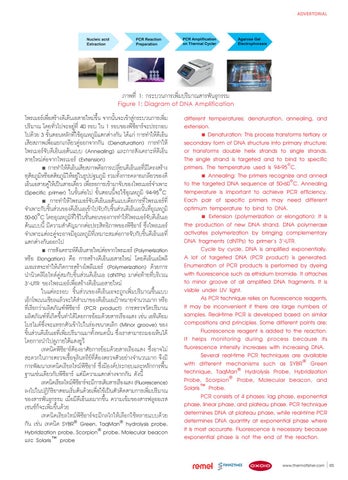ADVERTORIAL
ภาพที่ 1: กระบวนการเพิ่มปริมาณสารพันธุกรรม
Figure 1: Diagram of DNA Amplification
ไพรเมอร์เพือ่ สร้างดีเด็นเอสายใหม่ขนึ้ จากนัน้ จะเข้าสูก่ ระบวนการเพิม่ ปริมาณ โดยทั่วไปจะอยู่ที่ 40 รอบ ใน 1 รอบของพีซีอาร์จะประกอบ ไปด้วย 3 ขัน้ ตอนหลักทีใ่ ช้อณ ุ หภูมแิ ตกต่างกัน ได้แก่ การทำ�ให้ดเี อ็น เสียสภาพเพื่อแยกเกลียวคู่ออกจากกัน (Denaturation) การทำ�ให้ ไพรเมอร์จับดีเอ็นเอต้นแบบ (Annealing) และการสังเคราะห์ดีเอ็น สายใหม่ต่อจากไพรเมอร์ (Extension) การทำ�ให้ดเี อ็นเสียสภาพคือการเปลีย ่ นดีเอ็นเอทีม่ โี ครงสร้าง ทุตยิ ภูมหิ รือตติยภูมใิ ห้อยูใ่ นรูปปฐมภูมิ รวมทัง้ การคลายเกลียวของดี เอ็นเอสายคูใ่ ห้เป็นสายเดีย่ ว เพือ่ รอการเข้ามาจับของไพรเมอร์จ�ำ เพาะ (Specific primer) ในขั้นต่อไป ขั้นตอนนี้จะใช้อุณหภูมิ 94-95°C การทำ�ให้ไพรเมอร์จับดีเอ็นเอต้นแบบคือการที่ไพรเมอร์ที่ จำ�เพาะกับชิน้ ส่วนของดีเอ็นเอเข้าไปจับกับชิน้ ส่วนดีเอ็นเอนัน้ ทีอ่ ณ ุ หภูมิ 50-60°C โดยอุณหภูมทิ ใี่ ช้ในขัน้ ตอนของการทำ�ให้ไพรเมอร์จบั ดีเอ็นเอ ต้นแบบนี้ มีความสำ�คัญมากต่อประสิทธิภาพของพีซีอาร์ ซึ่งไพรเมอร์ จำ�เพาะแต่ละคูจ่ ะอาจมีอณ ุ หภูมทิ เี่ หมาะสมต่อการจับกับชิน้ ดีเอ็นเอที่ แตกต่างกันออกไป การสังเคราะห์ดเี อ็นสายใหม่ตอ ่ จากไพรเมอร์ (Polymerization หรือ Elongation) คือ การสร้างดีเอ็นเอสายใหม่ โดยดีเอ็นเอโพลี เมอเรสจะทำ�ให้เกิดการสร้างโพลีเมอร์ (Polymerization) ด้วยการ นำ�นิวคลีโอไทด์คู่สมกับชิ้นส่วนดีเอ็นเอ (dNTPs) มาต่อท้ายที่บริเวณ 3’-UTR ของไพรเมอร์เพื่อสร้างดีเอ็นเอสายใหม่ ในแต่ละรอบ ชิ้นส่วนของดีเอ็นเอจะถูกเพิ่มปริมาณขึ้นแบบ เอ็กโพเนนเชียลแล้วจะได้ส�ำ เนาของดีเอ็นเอเป้าหมายจำ�นวนมาก หรือ ที่เรียกว่าผลิตภัณฑ์พีซีอาร์ (PCR product) การตรวจวัดปริมาณ ผลิตภัณฑ์ที่เกิดขึ้นทำ�ได้โดยการย้อมด้วยสารเรืองแสง เช่น เอทิเดียม โบรไมด์ซึ่งจะแทรกตัวเข้าไปในร่องขนาดเล็ก (Minor groove) ของ ชิ้นส่วนดีเอ็นเอที่เพิ่มปริมาณมาทั้งหมดนั้น ซึ่งเราสามารถมองเห็นได้ โดยการนำ�ไปดูภายใต้แสงยูวี เทคนิคพีซีอาร์ต้องอาศัยการย้อมด้วยสารเรืองแสง ซึ่งอาจไม่ สะดวกในการตรวจเชื้อจุลินทรีย์ที่ต้องตรวจตัวอย่างจำ�นวนมาก จึงมี การพัฒนาเทคนิคเรียลไทม์พซี อี าร์ ซึง่ มีองค์ประกอบและหลักการพืน้ ฐานเช่นเดียวกับพีซีอาร์ แต่มีความแตกต่างจากกัน ดังนี้ เทคนิคเรียลไทม์พซี อี าร์จะมีการเติมสารเรืองแสง (Fluorescence) ลงไปในปฏิกริ ยิ าตอนเริม่ ต้นด้วยเพือ่ ใช้เป็นตัวติดตามการเพิม่ ปริมาณ ของสารพันธุกรรม เมื่อมีดีเอ็นเอมากขึ้น ความเข้มของสารฟลูออเรส เซนซ์ก็จะเพิ่มขึ้นด้วย เทคนิคเรียลไทม์พีซีอาร์จะมีกลไกให้เลือกใช้หลายแบบด้วย กัน เช่น เทคนิค SYBR® Green, TaqMan® hydrolysis probe, Hybridization probe, Scorpion® probe, Molecular beacon และ Solaris™ probe
different temperatures; denaturation, annealing, and extension. Denaturation: This process transforms tertiary or secondary form of DNA structure into primary structure; or transforms double helix strands to single strands. The single strand is targeted and to bind to specific primers. The temperature used is 94-95°C. Annealing: The primers recognize and anneal to the targeted DNA sequence at 50-60°C. Annealing temperature is important to achieve PCR efficiency. Each pair of specific primers may need different optimum temperature to bind to DNA. Extension (polymerization or elongation): It is the production of new DNA strand. DNA polymerase activates polymerization by bringing complementary DNA fragments (dNTPs) to primer’s 3’-UTR. Cycle by cycle, DNA is amplified exponentially. A lot of targeted DNA (PCR product) is generated. Enumeration of PCR products is performed by dyeing with fluorescence such as ethidium bromide. It attaches to minor groove of all amplified DNA fragments. It is visible under UV light. As PCR technique relies on fluorescence reagents, it may be inconvenient if there are large numbers of samples. Real-time PCR is developed based on similar compositions and principles. Some different points are; Fluorescence reagent is added to the reaction. It helps monitoring during process because its fluorescence intensity increases with increasing DNA. Several real-time PCR techniques are available with different mechanisms such as SYBR® Green technique, TaqMan® Hydrolysis Probe, Hybridization Probe, Scorpion® Probe, Molecular beacon, and Solaris™ Probe. PCR consists of 4 phases: lag phase, exponential phase, linear phase, and plateau phase. PCR technique determines DNA at plateau phase, while real-time PCR determines DNA quantity at exponential phase where it is most accurate. Fluorescence is necessary because exponential phase is not the end of the reaction. www.thermofisher.com
65
